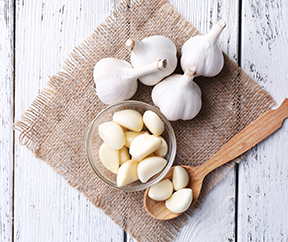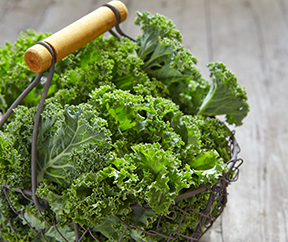Yates Account
Join now
Create a Yates account today!
Sign up to join the Yates Garden Club for monthly e-mails packed with seasonal inspiration, tips for success & exclusive promotions.
Plus if you’re a Garden Club member you can take part in the Yates Growing Community - a blog to share successes, get advice & win prizes in fun challenges along the way!

Forgot password
Enter the email address associated with your account, and we'll email you a new password.

Grow your own garlic
If you’ve ever wondered where store bought minced garlic comes from or exactly how cloves of garlic have been grown, then you’ll be pleased to know that growing your own garlic at home can be very easy (and then you’ll know all about where it comes from!).
Garlic is such a delicious ingredient in so many recipes and autumn is the time to get bulbs into the ground.
Here are the easy steps to grow your own garlic:
Step 1: Find a sunny spot in a garden bed that you can dedicate to growing garlic for around 8 months. It does take a while to grow and mature. Ideally the soil should be well drained and on the slightly acidic side (pH of around 6). Raised garden beds are ideal for growing garlic. If you have alkaline soil (pH above 7), then applying some Yates Soil Acidifier Liquid Sulfur can help reduce the soil pH. You can also grow garlic in a pot – the bigger the pot the easier it will be to maintain (and the more garlic you can grow), so choose a pot that’s at least 30 cm in diameter.
Step 2: Mix some Yates Thrive Natural Blood Bone with Seaweed into the garden soil or potting mix. This helps increase the amount of organic matter in the soil which attracts earthworms and soil microbes, helps retain moisture and nutrients in the soil and promotes better soil structure. Yates Thrive Natural Blood Bone with Seaweed will also provide the garlic with slow release organic nutrients as it establishes.
Step 3: It’s best to buy fresh garlic cloves from a garden centre as garlic purchased in a supermarket may have been sprayed with a sprouting inhibitor and may not grow.
Step 4: Plant the garlic cloves around 4 cm deep with the pointy end facing up, leaving around 10 cm between each clove.
Step 5: After planting, water the garden bed or pot well and apply a 5 cm layer of mulch like sugar cane or pea straw. This will help keep the soil moist.
Step 6: When the first garlic shoots emerge through the mulch, start feeding every fortnight with Yates Thrive All Purpose Soluble Plant Food. It’s a complete plant food that’s high in nitrogen to promote healthy leaf growth as well as phosphorus and potassium to encourage development of good-sized garlic bulbs. Keep feeding and watering regularly.
After around 8 months, or when a few of the leaves start to die back, it’s time to harvest. Hang harvested plants (with the leaves still attached) in an airy sheltered spot for about a month to dry and cure, then it’s ready to use.
Leafy goodness

Whether you whizz it up in a green smoothie, use in a stir fry, bake into chips, add to a frittata or mix in with pasta or rice dishes, kale is a healthy and versatile vegie that’s become increasingly popular over recent years.
Kale is rich in vitamins, minerals and dietary fibre, as well as having the health benefits of other plants in the brassica family. Yates Kale Tuscan is a mild flavoured variety that can be cut from around 7 weeks.
Kale Growing Guide:
Growing -
-
Kale can be sown directly where they are to grow or sown 6mm deep in trays filled with seed raising mix and the seedlings transplanted into a sunny or semi shade spot when around 4-6 cm high.
-
Kale can also be grown in containers, making it ideal for courtyard and balcony gardens.
-
It’s important to feed leafy vegies like kale with a nitrogen (N) rich complete plant food, with nitrogen being the key nutrient that promotes green leaf growth. A ‘complete’ plant food is one that contains the 3 main elements for plant growth – nitrogen (N), phosphorus (P) and potassium (K).
-
Seaweed alone does not provide plants with all the nutrition they require for healthy growth and can result in poorly performing plants and a reduced harvest. It’s easy to supply kale with all the nutrients it needs by feeding each week with Yates Thrive Vegie Herb Liquid Plant Food, a complete plant food that’s rich in nitrogen.
-
Dilute 1 – 2 capfuls in a 9 L watering can and apply over the foliage and surrounding soil or potting mix for container grown kale.
Protecting-
-
Protect young kale seedlings from snails and slugs with a light sprinkling of Yates Blitzem Snail Slug Pellets. And keep an eye out for small white butterflies which flutter around the vegie patch. They are likely to be cabbage white butterflies, which lay their yellow eggs onto the leaves of brassica vegies like kale.
-
Tiny but voracious caterpillars hatch out of these eggs and soon grow into green caterpillars around 3 cm long which can decimate kale leaves. Yates Success Ultra Insect Control concentrate is an easy way to control caterpillars on kale. Spray kale every 1 – 2 weeks, ensuring leaves are sprayed to the point of run off.
















Share
Share this article on social media